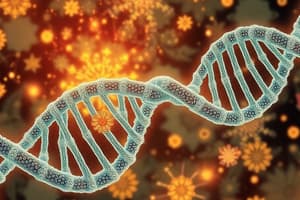Podcast
Questions and Answers
During DNA replication, if a strand of DNA has the sequence 'GCATTC', what would be the sequence of its complementary strand?
During DNA replication, if a strand of DNA has the sequence 'GCATTC', what would be the sequence of its complementary strand?
- TAAGCG
- CGTAAG (correct)
- GCATTC
- ATTCGC
The 'uprights' of a DNA molecule's ladder structure are composed of alternating nitrogen base and phosphate units.
The 'uprights' of a DNA molecule's ladder structure are composed of alternating nitrogen base and phosphate units.
False (B)
In DNA, which nitrogenous base pairs with Adenine?
In DNA, which nitrogenous base pairs with Adenine?
Thymine
The process of creating an exact copy of DNA during cell division is called ________.
The process of creating an exact copy of DNA during cell division is called ________.
Match the nitrogenous base to its corresponding pair in a DNA molecule:
Match the nitrogenous base to its corresponding pair in a DNA molecule:
Flashcards
What is a DNA double helix?
What is a DNA double helix?
A molecule with a twisted ladder shape that contains our genes.
What are DNA uprights?
What are DNA uprights?
Chains of sugars and phosphates that form the sides of the DNA ladder.
What are nitrogen bases?
What are nitrogen bases?
Molecules containing nitrogen that form cross-bridges in DNA.
What are complementary base pairs?
What are complementary base pairs?
Signup and view all the flashcards
What is DNA replication?
What is DNA replication?
Signup and view all the flashcards
Study Notes
- Genes on chromosomes interact to produce inherited characteristics.
- Genes are made of DNA.
The Structure of DNA
- A DNA molecule is called a double helix, shaped like a twisted ladder.
- Uprights of the DNA ladder consist of alternating sugar and phosphate units.
- Ladder rungs are pairs of nitrogen-containing molecules called nitrogen bases, forming cross-bridges.
- There are four nitrogen base molecules: adenine (A), thymine (T), cytosine (C), and guanine (G).
- Each base can pair with only one other due to its chemical structure.
- Complementary base pairs: A with T, and C with G.
- For a DNA strand with the base sequence ATTCGTC, the complementary strand would have the sequence TAAGCAG.
- The sequence of bases along DNA strands is the basis of heredity.
Copying DNA
- DNA is copied during mitosis in a process called replication.
- DNA strands are unzipped, and an exact copy is made by matching each base with its complementary base.
- A copied section results in one old and one new strand zipped together to produce duplicate DNA.
Studying That Suits You
Use AI to generate personalized quizzes and flashcards to suit your learning preferences.




